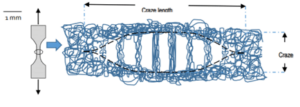 PHYS
PHYS
Physics of polymers
Measurement of the physical property in a solid state is at the centre of the PHYS division because this property is often required to validate the design of our materials. Our recent work focuses on developing original measurements by coupling properties by taking localised measurements on small scales or in a confined environment by probing the interfaces in complex materials. This approach is based on the constant development of experimental tools specific to each of the properties. The major physical properties studied concern:
Mechanical properties
- Elastic behaviour and breaking, large and small deformation of the material, behaviour under traction, compression, bending and dynamic stress (shock, fatigue, creep) on volumetric samples and on film.
 Monitoring of damage mechanisms in a volume of the material by measuring volume variations by image correlation to highlight cavitation phenomena at charged polymer interfaces
Monitoring of damage mechanisms in a volume of the material by measuring volume variations by image correlation to highlight cavitation phenomena at charged polymer interfaces- Micromechanics of interfaces and modelling: testing of microdrips, ravelling, cleavage, fragmentation
- Coupling of techniques: Monitoring of mechanical properties by X-ray or microscopy
- Mapping of local mechanical properties on small scales by atomic force microscopy
Electrical and dielectric properties
- Molecular mobility analysis by dielectric spectroscopy
- In volumetric materials, at interfaces in multi-materials
- In a confined environment with infinitely small quantities of material
- In reactive media: in situ dielectric monitoring of phase changes
 Insulation vs electrical conduction
Insulation vs electrical conduction- Percolation in conductive polymer composites, PTC and PVC effect materials, high-permittivity hybrid materials, electrical insulation materials (cables, high-power modules), high-voltage electrical conductivity
- Dielectric and thermal behaviour of interfaces and modelling
Small molecule transport properties
-
Characterisation of the permeation and sorption properties of small molecules, such as water (in the vapour and liquid state), permanent gases or organic compounds through polymer materials:
-
Materials with controlled transport properties
-
Highly permeable and/or highly selective materials (addition of porous loads, addition of mobile compounds, etc.)
-
Passive barrier (addition of waterproof charges, mixture of polymers, deposit of thin-layer barriers by plasma treatment, multilayer system, stretching, etc.)
-
Active barrier (in situ generation of metal nanoparticles, selective reaction/retention
-
Finite-element modelling
-
Hydration mechanisms and modelling
-
Analysis of water and gas transport mechanisms at different membrane hydration levels for the fuel cell domain

Chain mobility, confinement, interface issues and the multi-scale character are scientific concepts common to the three major properties studied, and need to be understood and controlled to optimise the final property of the material. This knowledge is used to identify the relevant parameters governing the property to create homogeneous or multiphase-functional or multifunctional polymer materials.